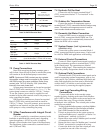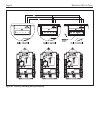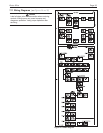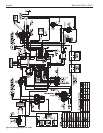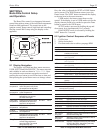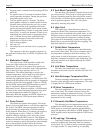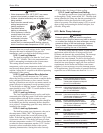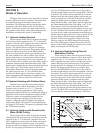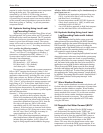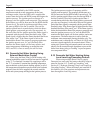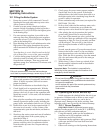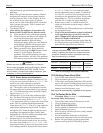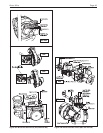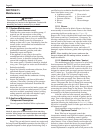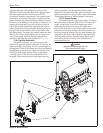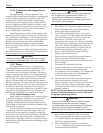
Brute Elite
Page 41
setpoint is used to limit the maximum water temperature
leaving the boiler only. The modulation rate is
controlled by a 4-20mA (0-10Vdc using converter)
signal supplied by an external control. When setting up
a system using an external control care must be taken to
set the external control algorithms to prevent the boiler
from short cycling or "hunting " to prevent premature
component failure.
9.5 Hydronic Heating Using Local Lead-
Lag/Cascading Feature
When using single or multiple Brute Elites in lead
lag configuration, the system sensor and TT terminals of
the Master boiler create heat demand. The TT terminals
on the slave boilers are ignored as the demand for those
heaters is given from the master control. The system
sensor is also used to control the modulation rate of the
lead lag system. (see Section 7 for wiring instructions).
Let’s consider the following example:
Three Brute Elite boilers (let’s call them “Lead”,
“Slave1” and “Slave2”) tied together via Modbus 1
connection, with appropriate RMT Address (1, 2, 3).
System sensor input is used to indicate common
secondary loop temperature.
System setpoint = 150°F
HS (hysteresis) = 10°F (default)
BL (base load) = 50% (default)
Anti-short-cycle = 5 minutes
Run sequence is initiated when system temperature
falls to 140°F (setpoint less hysteresis value). Lead
boiler will start. All firing rates will depend on several
application characteristics, including flow rate, system
load, water volume, etc. Boilers will start at a rate of
35%. If the load is such that Lead’s rate increases to
50%, “Slave1” will go through its startup sequence and
begin firing at 35%. At this point, both boilers (Lead
and Slave1) will continue to respond simultaneously to
the load/system characteristics, by modulating up or
down together, in relation to the relative system setpoint
and load characteristics.
Scenario 1: If the system loop temperature rises
quickly, and moves above setpoint, then the
boilers will simultaneously drop their firing rate. If
when reaching the point where both boilers drop
toward their minimum firing rate (20%), then the
first slave will drop out. Slave1 will remain
unavailable until its ASC timer has expired (5
minutes). If the load were to increase such to drive
all active boilers to 50% firing rate or more, during
the ASC time, Slave2 will begin its startup se-
quence and begin to fire at 35%, etc.
Scenario 2: If the system loop temperature continues to
drop (load increases), then the two boilers will
increase firing rate together. At 50%, Slave2 will
begin its firing sequence and be added to the group.
All three boilers will continue to fire simultaneously at
equal input rates or…
1. Modulation rate approaches minimum firing rate
(20%), in which case Slave2 will first drop out,
and then Slave1, accordingly.
2. System temperature reaches 10F (HS- hysteresis
value) above setpoint (e.g. 160F), in which case
remaining boiler will shut off
3. Any of the boilers approach its high limit tempera-
ture the individual boiler will modulate back.
9.6 Hydronic Heating Using Local Lead-
Lag/Cascading Feature with Indirect
Hot Water
When using the lead lag boiler system to provide
indirect domestic hot water heating, the DHW demand
should be supplied to the master boiler through the existing
DHW terminals. The lead lag system will change the
operating mode of the Master boiler only to supply water at
the DHW setpoint. The remaining boilers on the system
will continue to supply hydronic heating.
When the system is supplying both hydronic heat and
domestic hot water at the same time both the system pump
and DHW pump contacts are closed, so special attention
must be paid to allow for proper operation. During a DHW
call, the master boiler pump may need to be turned off in
applications serving both hydronic and domestic heating.
This will cause the DHW pump to provide flow through
the boiler and indirect tank (pump must be sized properly)
when there is a DHW call. To turn off the boiler pump in
this application the "boiler pump interrupt" jumper should
be installed. The terminal block location is terminal block 5
(TB5) contacts labeled "boiler pump interrupt" in the
control panel.
9.7 Warm Weather Shutdown
Warm weather shutdown overrides a hydronic call
for heat when the outdoor air temperature is greater than
the warm weather shutdown setpoint. Warm weather
shutdown is always active whenever there is an outdoor
sensor attached to the control. To avoid warm weather
shutdown the warm weather shutdown temperature
should be increased as necessary. The warm weather
shutdown setpoint can be adjusted in SETUP mode,
using the SD menu.
9.8 Domestic Hot Water Demand (BNTV
only)
When using the Brute Elite for DHW heating a
call for heat must be supplied to the "DHW stat"
terminal located on terminal block 6 (TB6). The DHW
heating call can be from the supplied DHW sensor or
from an aquastat. If the DHW sensor is used the heater
operates to maintain the temperature at the DHW
sensor. This may allow the actual heater outlet water
temperature to exceed the DHW sensor setpoint. If an
aquastat is used to supply the DHW demand the heaters



